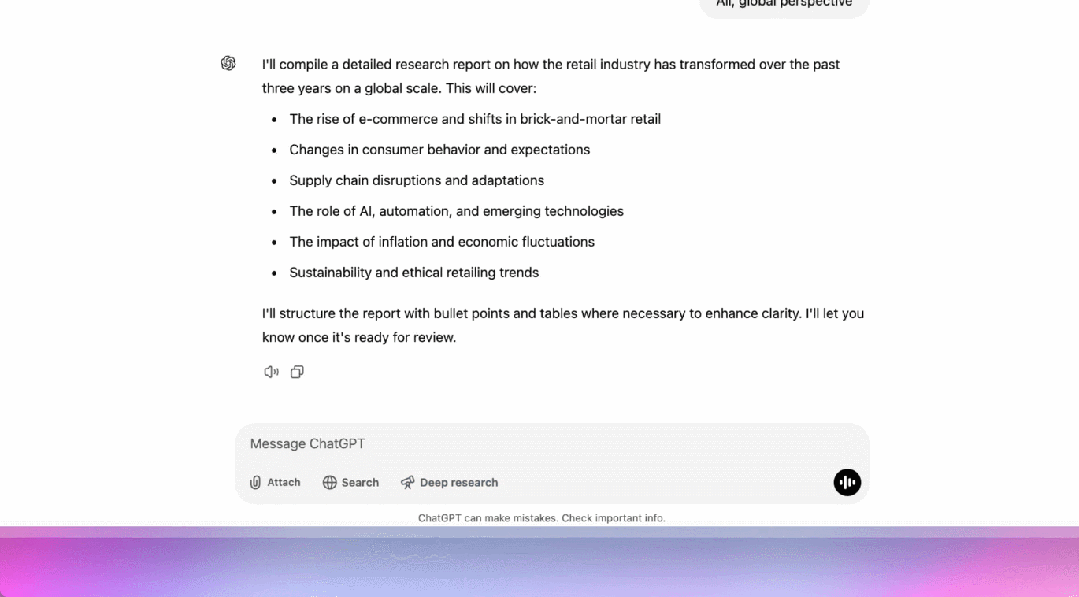OpenAI's Deep Research vs DeepSeek R1

Introduction
OpenAI's Deep Research and DeepSeek R1 are two advanced AI-driven research tools designed for deep information synthesis. While both tools are optimized for extensive web exploration and analysis, they have distinct methodologies and performance benchmarks that cater to different user needs.
Key Features Comparison
OpenAI's Deep Research
- Automated multi-step research with real-time adaptability
- Advanced reasoning capabilities for structured synthesis
- Integrated Python tools for data visualization and analytics
- Extensive citation documentation for credibility verification
- Optimized for professionals in finance, science, policy, and engineering
DeepSeek R1
- Optimized for high-precision search across diverse knowledge domains
- Strong performance in mathematical and technical tasks
- Built-in multilingual support for cross-lingual research
- Efficient processing speed with scalable infrastructure
- Focus on open-source research applications
Performance Benchmarks
Humanity’s Last Exam
- Deep Research achieved 26.6% accuracy on expert-level questions, excelling in chemistry, humanities, social sciences, and mathematics.
- DeepSeek R1’s performance has not been explicitly benchmarked on this exam but is known for its superior mathematical problem-solving abilities.
GAIA Benchmark
- Deep Research: Outperformed previous AI models in real-world research tasks with state-of-the-art results in reasoning and tool use.
- DeepSeek R1: Not specifically tested in GAIA but excels in algorithmic problem-solving and scientific computation.
Use Cases
OpenAI's Deep Research
- Complex Research Tasks: Example—Identifying iOS and Android adoption rates, language-learning preferences, and mobile penetration changes across multiple countries.
- Expert-Level Problem Solving: Example—Conducting technical analysis on mixed-gas sorption in glassy polymers for scientific research.
DeepSeek R1
- Advanced Mathematical Computation: Example—Solving high-order differential equations and scientific simulations.
- Cross-Lingual Knowledge Retrieval: Example—Synthesizing research in multiple languages to provide broader perspectives.
Limitations
OpenAI's Deep Research
- Potential for occasional factual hallucinations
- Challenges in distinguishing authoritative sources from rumors
- Some issues with confidence calibration
- Initial formatting inconsistencies in reports
DeepSeek R1
- Less optimized for structured knowledge synthesis
- Limited capability in citing sources explicitly
- Not tailored for multi-modal research tasks
Accessibility and Rollout
OpenAI’s Deep Research
- Available now for Pro users (up to 100 queries/month)
- Coming soon for Plus and Team users
- Expansion plans for Enterprise users and additional regions
DeepSeek R1
- Primarily available for academic and open-source research
- Focus on developer access via API integration
- Expansion into enterprise AI applications in progress
Future Developments
OpenAI's Deep Research
- Enhancing access to specialized and subscription-based data sources
- Integrating with OpenAI’s "Operator" for real-world task execution
- Expanding multimodal capabilities, including embedded analytics and interactive reports
DeepSeek R1
- Improved knowledge retrieval and summarization capabilities
- Expansion of real-time interactive research applications
- Greater emphasis on AI ethics and responsible AI research
Conclusion
Both OpenAI’s Deep Research and DeepSeek R1 push the boundaries of AI-powered knowledge synthesis. While Deep Research excels in structured research, citation management, and automated reasoning, DeepSeek R1 is more adept at solving complex mathematical and computational problems. The choice between the two depends on the specific needs of the user, whether for academic, technical, or policy-oriented research.
now SomeOne may find no entrance of Deep Research ,there is the way to access
you can acccess Deep Research through fanmade GPTs : click to use Deep Research Now